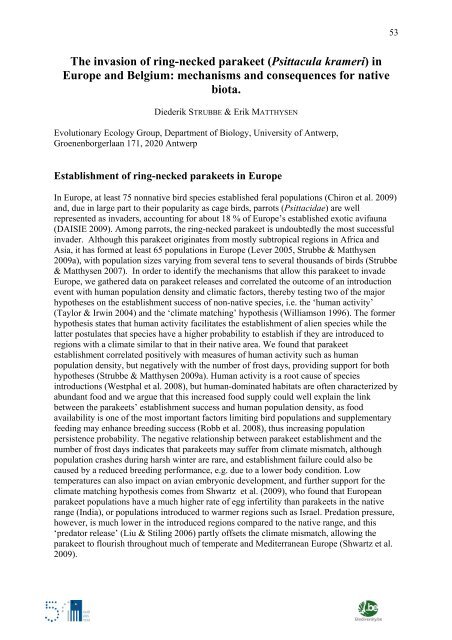Science Facing Aliens - Invasive Alien Species in Belgium - Belgian ...
Science Facing Aliens - Invasive Alien Species in Belgium - Belgian ...
Science Facing Aliens - Invasive Alien Species in Belgium - Belgian ...
Create successful ePaper yourself
Turn your PDF publications into a flip-book with our unique Google optimized e-Paper software.
The <strong>in</strong>vasion of r<strong>in</strong>g-necked parakeet (Psittacula krameri) <strong>in</strong><br />
Europe and <strong>Belgium</strong>: mechanisms and consequences for native<br />
biota.<br />
Diederik STRUBBE & Erik MATTHYSEN<br />
Evolutionary Ecology Group, Department of Biology, University of Antwerp,<br />
Groenenborgerlaan 171, 2020 Antwerp<br />
Establishment of r<strong>in</strong>g-necked parakeets <strong>in</strong> Europe<br />
In Europe, at least 75 nonnative bird species established feral populations (Chiron et al. 2009)<br />
and, due <strong>in</strong> large part to their popularity as cage birds, parrots (Psittacidae) are well<br />
represented as <strong>in</strong>vaders, account<strong>in</strong>g for about 18 % of Europe’s established exotic avifauna<br />
(DAISIE 2009). Among parrots, the r<strong>in</strong>g-necked parakeet is undoubtedly the most successful<br />
<strong>in</strong>vader. Although this parakeet orig<strong>in</strong>ates from mostly subtropical regions <strong>in</strong> Africa and<br />
Asia, it has formed at least 65 populations <strong>in</strong> Europe (Lever 2005, Strubbe & Matthysen<br />
2009a), with population sizes vary<strong>in</strong>g from several tens to several thousands of birds (Strubbe<br />
& Matthysen 2007). In order to identify the mechanisms that allow this parakeet to <strong>in</strong>vade<br />
Europe, we gathered data on parakeet releases and correlated the outcome of an <strong>in</strong>troduction<br />
event with human population density and climatic factors, thereby test<strong>in</strong>g two of the major<br />
hypotheses on the establishment success of non-native species, i.e. the ‘human activity’<br />
(Taylor & Irw<strong>in</strong> 2004) and the ‘climate match<strong>in</strong>g’ hypothesis (Williamson 1996). The former<br />
hypothesis states that human activity facilitates the establishment of alien species while the<br />
latter postulates that species have a higher probability to establish if they are <strong>in</strong>troduced to<br />
regions with a climate similar to that <strong>in</strong> their native area. We found that parakeet<br />
establishment correlated positively with measures of human activity such as human<br />
population density, but negatively with the number of frost days, provid<strong>in</strong>g support for both<br />
hypotheses (Strubbe & Matthysen 2009a). Human activity is a root cause of species<br />
<strong>in</strong>troductions (Westphal et al. 2008), but human-dom<strong>in</strong>ated habitats are often characterized by<br />
abundant food and we argue that this <strong>in</strong>creased food supply could well expla<strong>in</strong> the l<strong>in</strong>k<br />
between the parakeets’ establishment success and human population density, as food<br />
availability is one of the most important factors limit<strong>in</strong>g bird populations and supplementary<br />
feed<strong>in</strong>g may enhance breed<strong>in</strong>g success (Robb et al. 2008), thus <strong>in</strong>creas<strong>in</strong>g population<br />
persistence probability. The negative relationship between parakeet establishment and the<br />
number of frost days <strong>in</strong>dicates that parakeets may suffer from climate mismatch, although<br />
population crashes dur<strong>in</strong>g harsh w<strong>in</strong>ter are rare, and establishment failure could also be<br />
caused by a reduced breed<strong>in</strong>g performance, e.g. due to a lower body condition. Low<br />
temperatures can also impact on avian embryonic development, and further support for the<br />
climate match<strong>in</strong>g hypothesis comes from Shwartz et al. (2009), who found that European<br />
parakeet populations have a much higher rate of egg <strong>in</strong>fertility than parakeets <strong>in</strong> the native<br />
range (India), or populations <strong>in</strong>troduced to warmer regions such as Israel. Predation pressure,<br />
however, is much lower <strong>in</strong> the <strong>in</strong>troduced regions compared to the native range, and this<br />
‘predator release’ (Liu & Stil<strong>in</strong>g 2006) partly offsets the climate mismatch, allow<strong>in</strong>g the<br />
parakeet to flourish throughout much of temperate and Mediterranean Europe (Shwartz et al.<br />
2009).<br />
53


